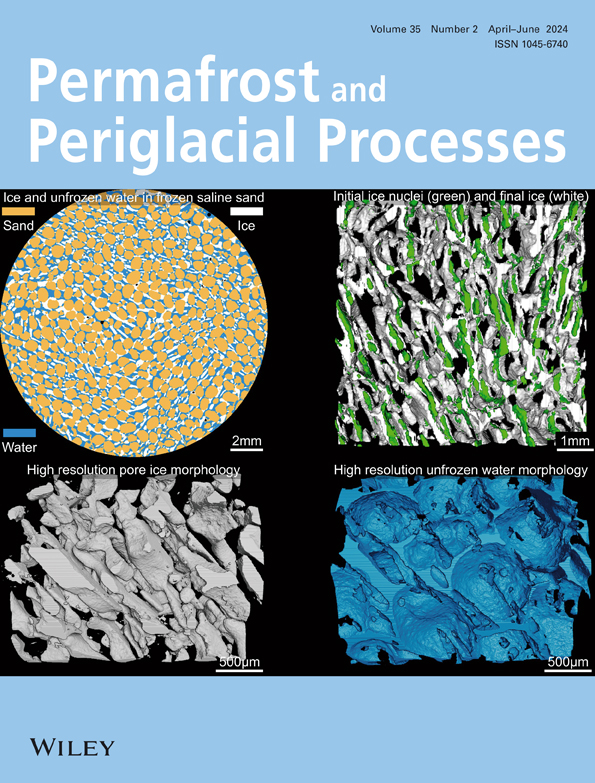Little tools, big job: The periglacial conveyor system in cryoplanated uplands
IF 3.3
3区 地球科学
Q2 GEOGRAPHY, PHYSICAL
引用次数: 0
Abstract
The mechanisms of sediment removal associated with the nivation process suite are underinvestigated, a situation that hinders development of a unified, coherent theory of cryoplanation terrace formation. This study links sorted stripes—a type of periglacial patterned ground frequently encountered on cryoplanation terrace treads—to active hydrologic networks capable of transporting large quantities of fine sediments on periglacial hillslopes. Traditional interpretations hold that the presence of sorted patterned ground indicates geomorphic quiescence, a view that has contributed to the dismissal of these features as a factor in the formation of erosional periglacial topography. We address the geomorphic role of sorted stripes as fluvial features by investigating their hydrologic potential for transporting weathered material across and off developing cryoplanation terraces. Flow modeling and watershed geomorphometric analyses were conducted using a high‐resolution digital elevation model of a large cryoplanation terrace in a geomorphically active periglacial upland near Atlin, British Columbia, Canada. Results demonstrate the landscape‐scale spatial organization and geomorphic effectiveness of sorted‐stripe networks—“little tools”—for transporting water and suspended sediment across large cryoplanated surfaces. We present a qualitative model of sediment production and transportation, “the periglacial conveyor system,” that outlines erosional processes responsible for cryoplanation terrace formation and defines the distinctive hydrologic–geomorphic imprint imparted by sorted stripes on periglacial hillslopes.小工具,大任务:冻土高地的冰缘输送系统
与nivation过程套件相关的沉积物去除机制尚未得到充分研究,这种情况阻碍了关于冷冻平台形成的统一、连贯理论的发展。这项研究将分选条纹(一种经常出现在冷冻平台踏板上的冰缘图案地面)与能够在冰缘山坡上输送大量精细沉积物的活跃水文网络联系起来。传统的解释认为,有序图案地面的存在表明地貌静止,这一观点有助于将这些特征视为侵蚀冰缘地形形成的一个因素。我们通过研究分选条纹的水文潜力,将风化物质输送穿过和偏离发育中的冷冻阶地,来解决分选条纹作为河流特征的地貌作用。流量建模和流域地貌计量分析是使用加拿大不列颠哥伦比亚省阿特林附近地貌活跃的冰缘高地的大型冷冻平台的高分辨率数字高程模型进行的。结果证明了分选条纹网络——“小工具”——在大型冷冻表面上运输水和悬浮沉积物的景观尺度空间组织和地貌有效性。我们提出了一个沉积物产生和运输的定性模型,即“冰缘输送系统”,该模型概述了导致低温阶地形成的侵蚀过程,并定义了冰缘山坡上分选条纹所赋予的独特水文地貌印记。
本文章由计算机程序翻译,如有差异,请以英文原文为准。
求助全文
约1分钟内获得全文
求助全文
来源期刊
CiteScore
9.70
自引率
8.00%
发文量
43
审稿时长
>12 weeks
期刊介绍:
Permafrost and Periglacial Processes is an international journal dedicated to the rapid publication of scientific and technical papers concerned with earth surface cryogenic processes, landforms and sediments present in a variety of (Sub) Arctic, Antarctic and High Mountain environments. It provides an efficient vehicle of communication amongst those with an interest in the cold, non-glacial geosciences. The focus is on (1) original research based on geomorphological, hydrological, sedimentological, geotechnical and engineering aspects of these areas and (2) original research carried out upon relict features where the objective has been to reconstruct the nature of the processes and/or palaeoenvironments which gave rise to these features, as opposed to purely stratigraphical considerations. The journal also publishes short communications, reviews, discussions and book reviews. The high scientific standard, interdisciplinary character and worldwide representation of PPP are maintained by regional editorial support and a rigorous refereeing system.

 求助内容:
求助内容: 应助结果提醒方式:
应助结果提醒方式:


